Ask-A-Pro: VW / Audi Paint Hardness
by Marc Harris & Jacob BunyanThis question was recently submitted on the DI Blog:
Dear DI,
… I read your Honda/Acura article about soft paint but I can’t seem to find any info on the VW paint. I was thinking of getting the PC 7424xp and the Meguiar’s M105/205 and the Blackfire Wet Diamond sealant. I have clayed both cars in the past but I was looking for advice on polishing these cars and a good high heat sealant. I don’t wan’t to mess up either car, especially the GTI…
Thanks for a wonderful site.
Best,
Ken
Given we have done quite a few VW/Audi and work closely with a specialized VW/Audi shop who outsources his detailing services to us, we figured we could post some good examples of how VW/Audi paint reacts to polishing, and give Ken plenty of ideas and inspiration.
Ken, every car brand has their own specifications and requirements for the paints and processes they use to apply them to their vehicles. Moreover, each specific paint combination will result in different hardnesses. Further, environmental wear takes place at different rates, which will affect the hardness and condition of the paint prior to polishing. So no two vehicles are exactly the same.
With this said, we can certainly group manufacturers into general categories based on typical results found among their vehicles. Honda can be categorized as softer than average. In general, Audi/VW can be categorized as average to harder than average. There are always fliers in the data, and specifically Honda has probably the softest paint we have dealt with (Berlina Black). VW has one if the hardest paints we have dealt with (B5 Passat in Burgundy), and one of the softest (2010 VW GTi in non-metallic black). In general, lighter colors seem to be harder than darker colors. Again, there are always fliers in the data.
Now, with your VW/Audi ready for polishing, how do you decide on polish and pad combination? Easy, use one of the most versatile combinations out there, with a Dual Action polisher like the PC7424: Meguiar’s M105 on an Orange Lake County pad + Meguiar’s M205 on a Black Lake County pad. This combination will work on almost any paint and provide plenty of correction and great refining capabilities. If you have a soft color, you will have to refine further by adding a step with something like Menzerna PO85RD on a Blue Lake County pad at very slow orbit speed. If you have a hard color, you can always increase the cutting action of the M105 by using an advanced technique like the Kevin Brown Method. Just make sure the M205 on black is indeed removing any marring caused by the aggressive M105 KBB Method. 2 to 3 passes with M205 on black usually takes care of anything left behind by an orange pad. White pads with M205 typically require further refining on anything but the hardest of paints. White pads are a great option for M105 for softer paints.
As far as sealants that resist higher temperatures, any of the sealants will work. Sealants resist heat cycles much better than waxes, and will last longer on your vehicle in your latitude. I like Klasse, although it is sightly more difficult to apply and remove. Blackfire has a deeper look, and goes on and off much easier. But any sealant will suffice. More important than what sealant to choose now, is the need to routinely wash and re-apply sealant to your vehicle. I would use a high-shine Quick Detailer like Dodo Juice Red Mist after each wash, and a new coat of sealant every month or two or after any harsh cleaning. Once you get the paint smooth and polished, sealing and subsequent applications will be very quick and easy.
Pictures!
Here is a picture of the Burgundy Passat Wagon we were unable to correct further. Not only was this vehicle in severe condition, the owner was not interested in further correction and had a budget to stick to. The vehicle still looks great and glossy, but further correction will require sanding and more time. Tools used were M105 on a Yellow pad using the Makita Rotary + a product equivalent to M205 (D151) on an Orange pad.
Before:
The challenge:
Looks great done:
But you can tell the deepest RIDS remain given the right light angle:
This B5 Passat Sedan had significant swirling and RIDS as well, but corrected much better with just M105 and an Orange pad:
Before:
After first few passes with M105:
This black Golf TDi had super soft paint. These defects required just a very quick pass of M105, and the rest of the paint just needed a light jeweling with Menzerna PO85RD and a blue pad on the PC 7424
Before:
After:
This 1990 Audi 100S showed years of abuse. It was corrected with M105 and an Orange pad.
This Audi A8L had very soft paint and very severe defects. Compounding with anything more than an Orange pad and M105 left too much marring, so we opted to do multiple passes with the Orange.
Right side = one pass of M105. Left side = two passes of M105:
After a few more passes:
Getting there:
This Audi A6 could have used some more time spent on correction, but M105 and an Orange pad made quick work of most of the defects in the paint:
Before:
During:
After:
This Passat CC in Metallic Black had just 2000 miles. Its paint was quite soft. Here we are using the slight increase in power from the Makita Rotary Polisher to up the cutting power of M205 and a Black pad. We used this finishing polish to correct the RIDS and swirls!
Looks good! Needs further refining but the M205 corrected sufficiently:
Also on this vehicle, the Paint Protection Film installed over the front end lacked clarity and needed some help. We used the PC 7424 with a Black pad on speed 5 with M205 to restore the transparency of this film, and reduce the appearance of the film per se. Notice the tape lines in the paint protection film where we have yet to apply polish showing the color and opacity the film had when we started. This made a huge difference in how the car looked overall, and make the film virtually invisible.
Hopefully this helps shed some light on how to tackle your VW/Audi’s paint!
Related Posts
- Ferrari F40: 60 Hour Restorative Detail by Todd Cooperider and Craig Reed
- 2008 Cadillac STS-V, Major Paint Correction
- 2008 Z06 Vette in Velocity Yellow Tintcoat by DJ Mayo of Reflections Detailing
- Full Detail and Paint Correction: Ferrari 458 Italia by Todd Cooperider of Esoteric Auto Detail
- 2006 Acura TL in Nighthawk Black Pearl (part 2)


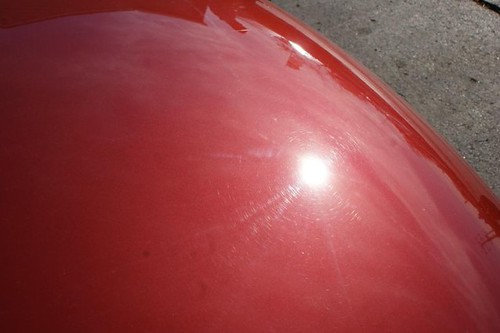
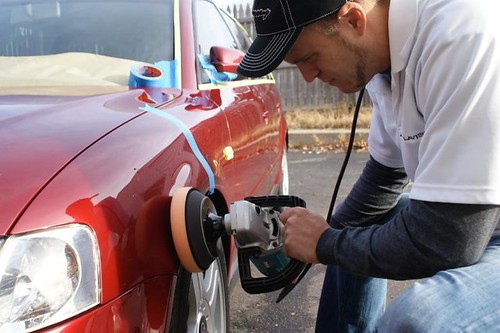
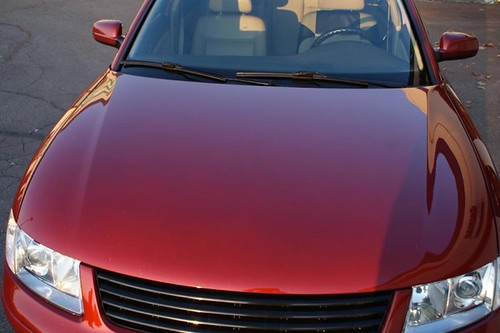
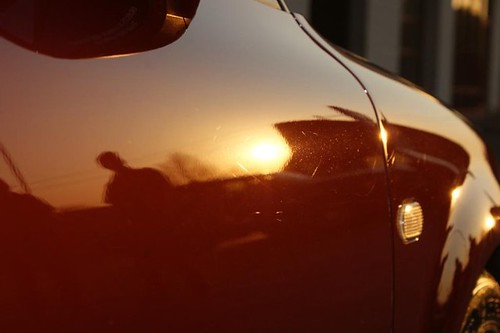
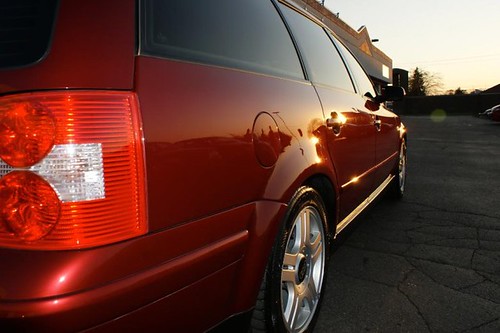
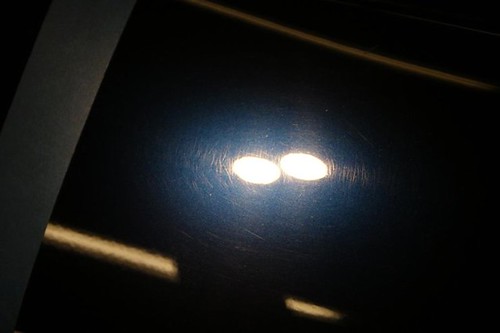
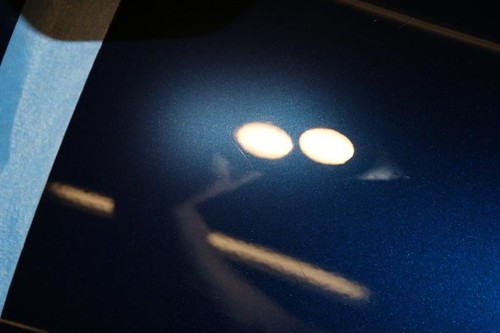

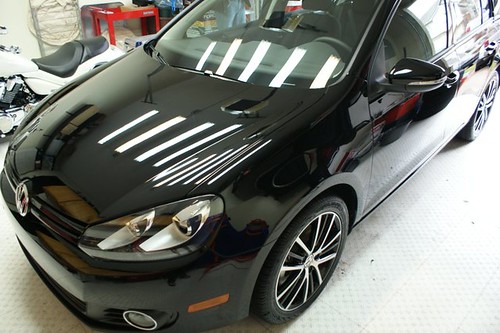
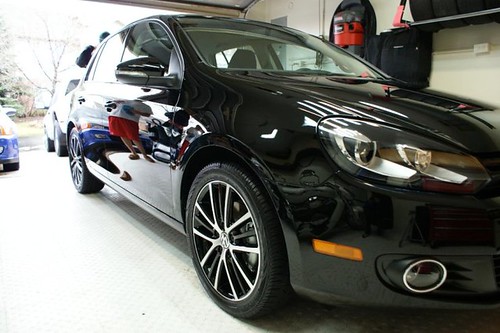
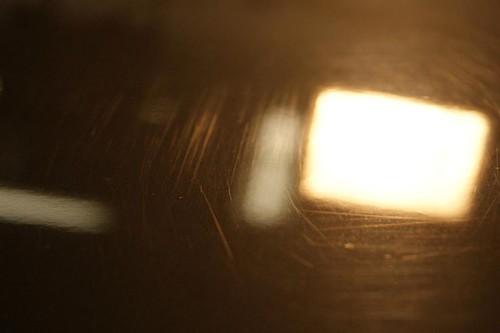
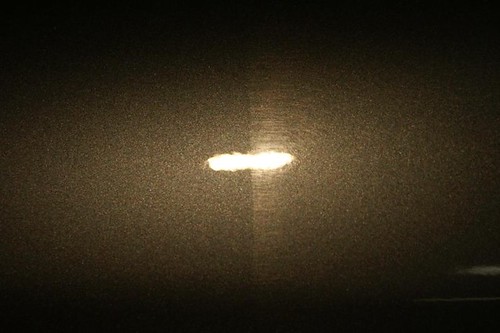
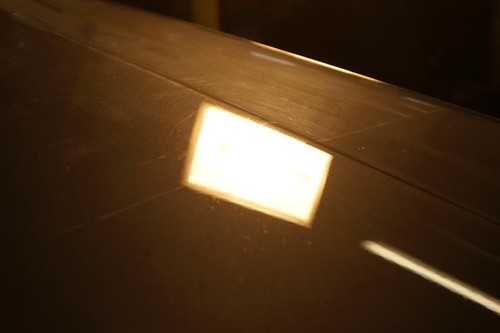
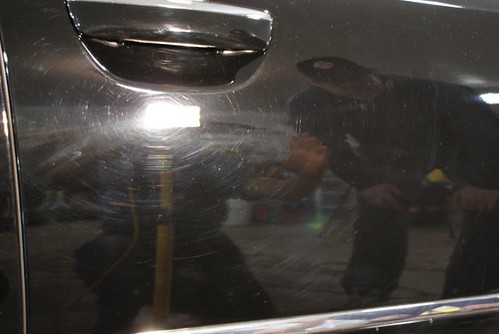
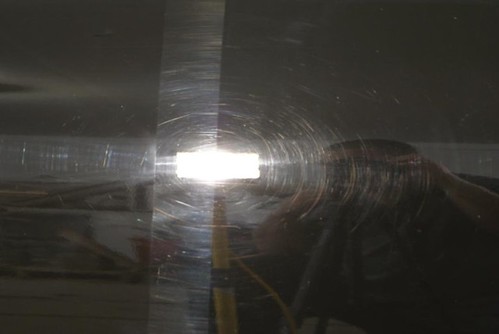
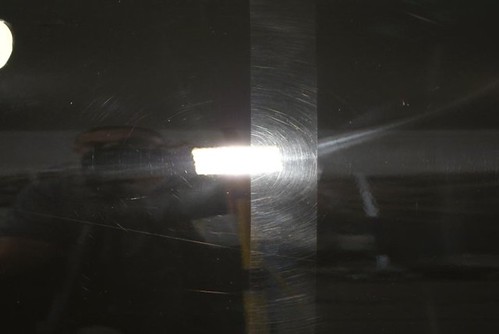
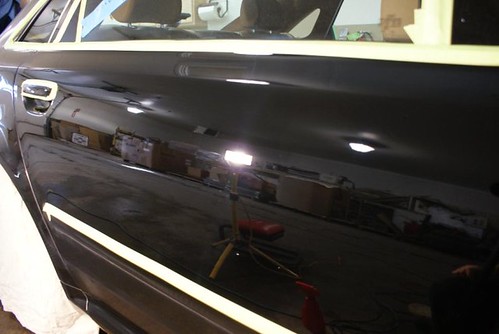
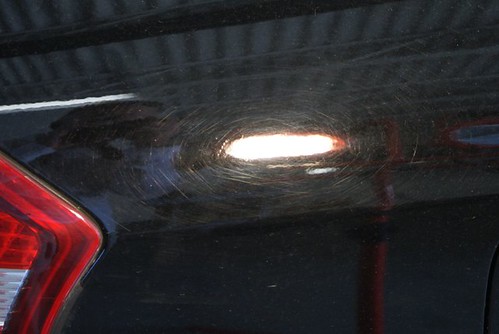
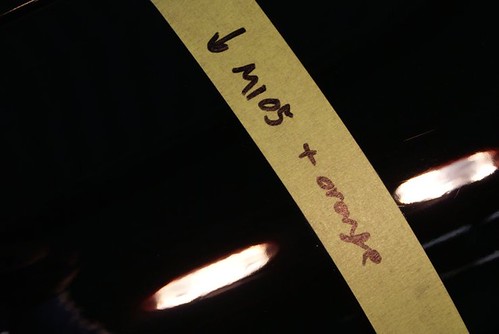
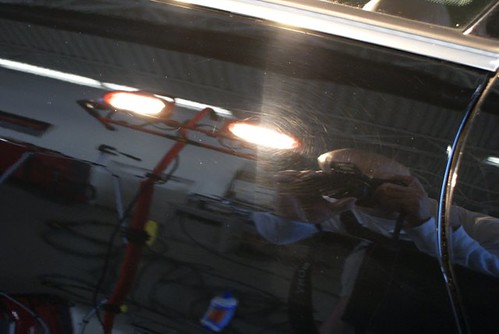
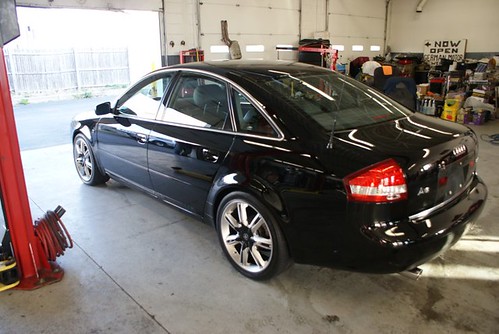
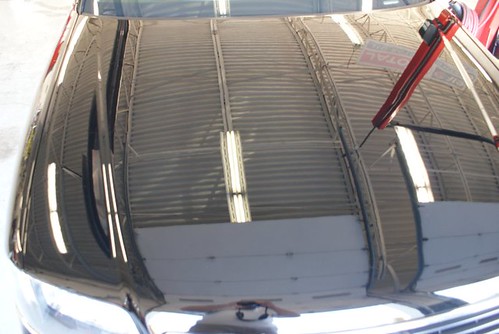
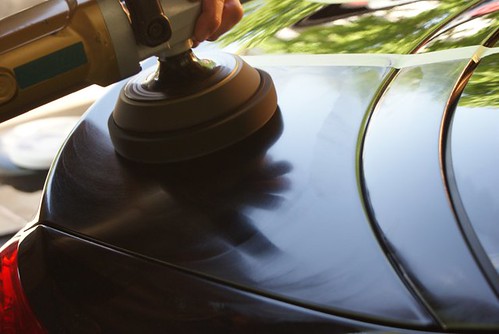
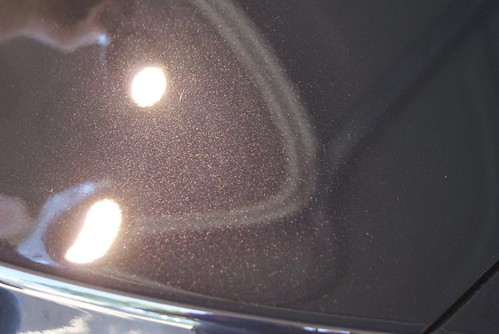
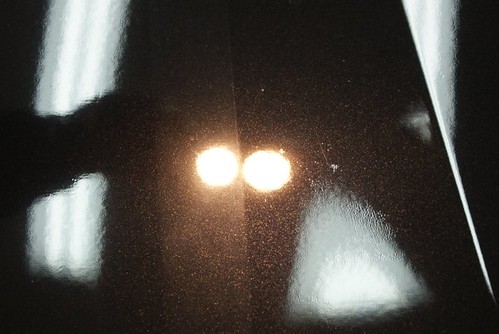
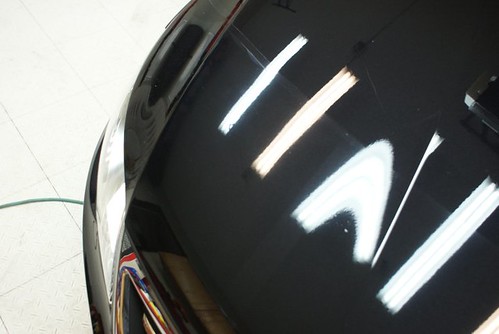







When you talked about the pad and compound leaving way too much marring, what does that mean? Do you have any pictures of this? Is it the same as when you induce swirling in the paint?
I want to try and avoid this as much as possible. Are different colors prone to this?
Thanks,
Tim
Hi Tim,
The term can be misleading! This is an issue we have to deal with in a different way than most people who are working on their own cars. SInce we work by the hour we always have a time limit and need to deliver perfection in that timeframe. Under these circumstances we are worried about imparting “too much marring”. Let me explain what this means and why it may not be very important in reality if you are working on your own car.
Marring is, basically, defects that are (usually) lighter than swirls, caused by sliding movements that are directed in a more straight fashion and leave longer “chains” of scratches, even columns or thick markings. Compared to swirls, which can be visualized as being very short straight scratches that seem to go around and around. But the most important thing is marring is easy to remove. It really isn’t a big deal as long as you can detect them. They are typical of any compounding step and are the reason finishing polishes exist in the first place.
We, and you, will run into marring after claying on softer paint. We will also find marring after compounding very hard. Think about this: my personal car has not seen an aggressive compound in over 4 years. I have used moderate and finishing polishes to clear up typical swirls caused by use, but once you correct the vehicle’s defects the first time you should not have to do it again in awhile. As long as you wash properly (read Todd’s 2+4 bucket method) your finish will be free of deep scratches, at least free from having them all over the vehicle. In the near future after you correct your paint you should only have to apply the lightest of polishes to get the surface you want. M205 is perfect for this since it’s breadth of performance means you will be able to correct any of the light swirling your vehicle will gain in the next few years. M105 will only be used for “spot correction” of you get a scuff or a cat climbs over the car, etc.
So it shouldn’t be something to avoid per se, but something to gage your progress with. If you do not have a time constraint, you can just add another polishing step with an intermediate pad or polish. If we would have used a wool or a yellow pad for the Audi A8L, we would have had to come back over with one pad step-down using M105, then again with another step-down (say from wool to yellow to orange to green or white). We just kept on using the orange instead. We have enough experience to forecast how that paint will react to one polish or pad based off the results from another, so we can do modifications to methods on the fly as needed. At home, I keep to the standard and take my time, one step at a time, using the Brinkmann Flashlights (both of them!). And unless you have a car with one of the very soft paints, “too much marring” will probably not occur even with an orange pad. It should all be removable fairly easily with subsequent steps.
Once you figure out what pad works best with your paint (no way to know for sure until you actually do it and inspect your results), you will be able to control how much marring you let happen before you change to a finishing polish. And it will happen only once or twice. And once you deal with it the first time you will be ready to tackle it on any other cars you polish.
Hope this helps!
Thanks a lot Marc. I appreciate your reminder of the fact that once you’ve compounded to remove the heavy duty defects you shouldn’t have to do it again if you wash correctly.
I completely understand your explanation. Time is money; but, haste can make more work if you aren’t careful. I’ve noticed that you guys test several areas with different compounds or polishes and tape each section off and label what you’ve used. That is a great method. Do you guys keep a journal or notebook with this information for use in the future?
Tim
Tim,
I’m glad you found the information valuable. We don’t usually don’t track any information other than what we used on an entire vehicle for documentation/write-up use. Part of this is because we don’t need to know what DIDN’T work, and the other factor is that you should always treat each car as a unique entity; you never know what will or won’t work on a car until you try it, and you should always use the least aggressive product that will get the job done.
I totally agree that haste can make more work down the road – just as hiring the wrong company to work on your car.
Happy detailing!
Marc,
Thanks for answering my email! I am about to get a large amount of products to tackle my silver honda element and very dark grey GTI. There are so many choices it is very dizzying and I don’t want to ruin the paint.
Ken
Ken,
I totally understand your concerns, but know there are many different things that can potentially work. As long as you get the type of results you want is the only concern. Take your time and good luck!
Great write up! A couple of months ago, I tried to correct a 2004 Jetta GL in Galactic Blue Metallic that had a ton of paint damage (swirl marks, bird dropping etchings, a stain from a coffee mug spill, etc.) and it was an incredibly hard paint. I used M105 and M205 on my PC 7427 along with a Lake Country orange, white, blue and finally a black finishing pad and the difference after all of that was minimal. The finish was in conjunction with the Blackfire wet ice over fire treatment and that ended up being the sorta redeeming step that made the car look better than when I started. The paint still had some swirl marks, but I chalked up to my inexperience but also what seemed to be a very difficult paint to correct down.
On the completely opposite end of the spectrum, I was able to remove some light scratches on my 2009 B6 Passat Komfort (Reflex Silver) with *very* minimal effort using the M205. I was shocked at how different the paints were. Thanks for your article!